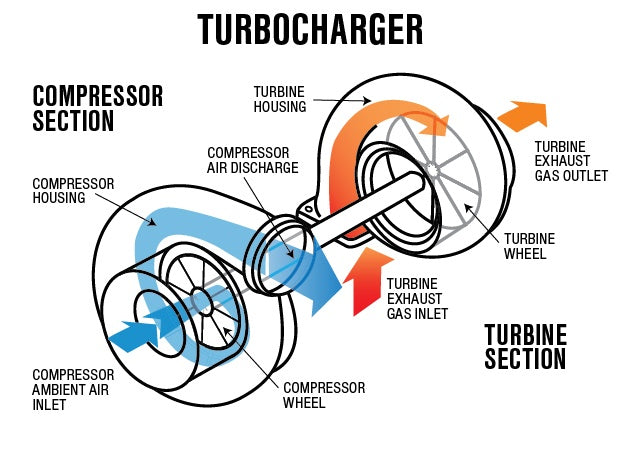
How to Clean Your Turbocharger
Share
One of the most common questions asked by customers to our service advisors is “How do I clean turbochargers?” Turbochargers boost your engine’s performance and we know how amazing that feels. However, if there’s one downside, it’s that carbon can build up with time and usage; thus the necessity for continuous cleaning and maintenance. Don’t worry though, it’s not as bad as it sounds.
Let’s start with a summary of how turbochargers work…
How Do Turbochargers Work?
A turbocharger has a compressor wheel and exhaust gas turbine wheel linked together by a shaft that is used to enhance the intake air pressure of an internal combustion engine. The exhaust gas turbine draws out energy from the exhaust gas and uses it to drive the compressor wheel to increase air intake. Turbochargers, as you may know, are used on virtually all diesel engines to boost power.
Why Do Turbochargers Accumulate Deposits?
There are quite a few factors…
- Short trips and/or stop-start driving will take its toll as the engine cannot reach sufficient temperature to optimize combustion quality and/or help burn off carbon deposits. During the engine’s warm-up cycle, more hydrocarbons are being produced.
- OIL. The carbon on diesel vehicles is a combination of fuel AND oil. The oil bypassing the piston rings will a) end up in the combustion chamber, b) not be totally combusted, and; c) end up deposited in areas such as the DPF, turbo, EGR, and more. Oil re-releasing from the crankcase breather system may also deposit within the intake system.
- Accumulated deposits in the combustion area and fuel system will cause additional hydrocarbons that will end up in post-combustion areas like the turbocharger.
Our Recommendation: Use 4+ Turbocharger Cleaner, Both Preventative & A Cure
Our 4+ Turbocharger Cleaner can:
- Free sticky turbocharger vanes
- Free up sticking actuators
- Clean EGR and prevent carbon deposits
- Clean exhaust after-treatment system
When to use:
- Immediately after replacing turbochargers
- Once a month to prevent carbon build-up leading to sticking vanes
- When the engine transmits turbo-actuator related codes
How much to apply:
To prevent sticking turbo vanes and expensive repairs, add entire contents (946ml/32oz bottle) to 500L of diesel fuel. For severe problems and faster cleanup, fill the fuel filter and add the remainder of contents to 100L of diesel fuel. Use at least once a month to keep the turbocharger in optimal condition. Don’t worry about over-treating. This is a case where more is better.
We do not claim that this is the only way to clean turbos or prevent the accumulation of deposits, but we believe in our brand! 4+ represents the science behind modern diesel engines and a high level of ‘active ingredients’ that will result in lower treatment costs and ensure that you are getting the utmost value.
If you need further or specific advice on your engine, equipment, or vehicle’s turbo, call or text us at (306) 242-7644 or email us directly.
Photo credit: https://www.eagleridgegm.com/what-is-a-turbocharger-and-how-does-it-work/
